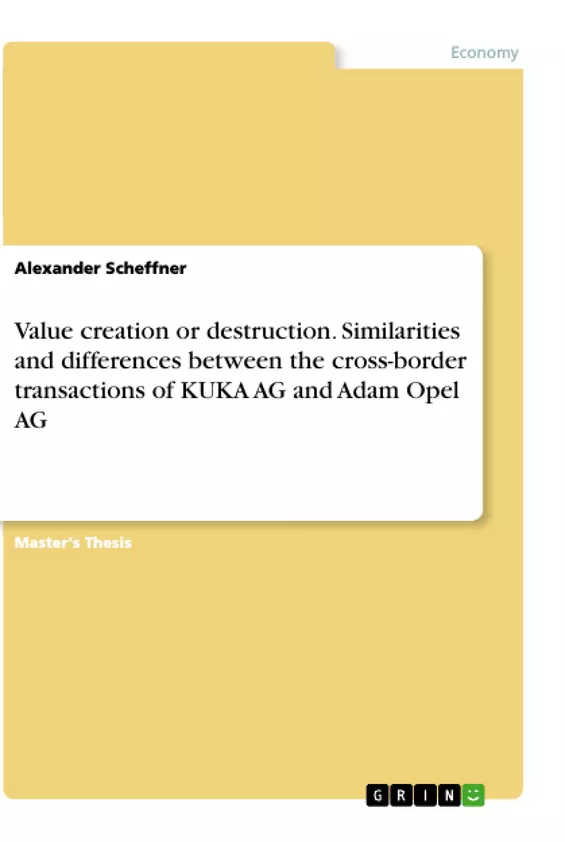The global Mergers & Acquisitions (M&A) market has reached new all-time highs since the meltdown of the financial crisis in 2008. In 2015, the global M&A transaction volume reached its peak amounting to USD 4.7 trillion. While this way of strategic inorganic growth is often aimed at creating value to its shareholders and stakeholders respectively, the major concern of value creation using M&A remains. Recent studies testify a negative performance from the buyers’ perspective, as such as about 60% - 70% of all M&A transactions fail to generate value.
Among others, the reasons include flawed valuation and thus overestimations of synergies and to unexpected high integration costs lead to value destruction. While these reasons hold true for domestic acquisitions and developed markets, there are further reasons for cross-border transactions, particularly for China, as Chinese buyer play an increasing role in worldwide M&A activities. Value destruction in such cross-border transactions is mostly associated with cultural differences, poor communications between the involved parties, lack of experience or local market know how.
The findings suggest that the probability of value creation is higher if a buyer has broad experience in M&A activities, undertakes many small acquisitions, focus on cost reduction rather than growth motives and understands the market of the target company. The acquisitions of KUKA AG and Opel AG show many positive attributes, which lead to a higher probability of value creation. Beyond that, both companies are familiar with their targets and gained experience in acquisitions, which further reduce the factors that might lead of value destruction.
Inhaltsverzeichnis (Table of Contents)
- Abstract
- Contents
- List of Figures
- List of Tables
- List of Abbreviations
- A: Theoretical Part
- 1 Introduction
- 2 Business Alliances – Alternatives to M&A
- 2.1 Definition of business alliances
- 2.2 Forms of business alliances, benefits and drawbacks
- 3 Mergers and Acquisitions
- 3.1 Definition of and types of M&A
- 3.2 Motives, benefits and drawbacks of M&A
- 3.3 Advantage and disadvantages of M&A relative the alternatives
- 3.4 Corporate takeover market and common practice
- 4 The M&A Process
- 4.1 Stage 1 – Strategic analysis and concept
- 4.2 Stage 2 – Transaction
- 4.3 Stage 3 – Post merger integration
- B: Practical Part
- 5 Value definition and valuation basics
- 5.1 Definition of value
- 5.2 Restructuring value
- 5.3 Stakeholder vs. shareholder value and value drivers
- 5.4 Value of synergies
- 5.5 Value creation in cross-border M&A
- 5.6 Common calculation methods
- 5.7 Multiples (relative valuation)
- 5.8 Discounted cash flow
- 6 Pre-merger analysis and valuation by the example of KUKA AG
- 6.1 M&A market and process in China
- 6.2 Pre-merger analysis
- 6.3 Screening of KUKA AG
- 6.4 Valuation by transaction multiples
- 6.5 DCF Valuation of KUKA AG and Midea Group
- 6.5.1 Risk parameters and cost of capital (WACC)
- 6.5.2 Estimation of earnings and cash flows
- 6.5.3 Estimation of growth rate
- 6.5.4 Terminal value calculation
- 6.5.5 Summary and results of DCF model
- 6.6 Synergy projection and evaluation of takeover effects
- 6.7 Interim result
- 7 Pre-merger analysis and valuation by the example of the Adam Opel AG
- 7.1 Screening of Opel AG
- 7.2 Valuation of by CTA multiples
- 7.3 DCF Valuation
- 7.3.1 Estimation of risk parameters and cost of capital
- 7.3.2 Estimation of earnings and cash flows
- 7.3.3 Estimation of growth rate
- 7.3.4 Terminal value calculation
- 7.3.5 Summary and results of DCF model
- 7.4 Synergy projection and evaluation of takeover effects
- 7.5 Second interim result
- 8 Discussion and outlook
- References
- List of Appendices
- Mergers and acquisitions as a strategic instrument to enhance competitive position.
- The role of cultural differences in cross-border M&A transactions.
- Valuation methods and their application in assessing value creation or destruction.
- Synergy potential and its importance in M&A transactions.
- The impact of the M&A environment and key industry trends on value creation.
Zielsetzung und Themenschwerpunkte (Objectives and Key Themes)
The main objective of this master thesis is to analyze the similarities and differences between the cross-border transactions of KUKA AG and Adam Opel AG. The analysis aims to determine whether value was created or destroyed through these acquisitions and identify the factors that significantly impact value creation.
Zusammenfassung der Kapitel (Chapter Summaries)
The theoretical part of the thesis provides a comprehensive overview of mergers and acquisitions (M&A), including alternative strategies like business alliances, various types of M&A, and the common practice of takeover processes. The M&A process is outlined in three stages: pre-merger, transaction, and post-merger integration. Chapter 5 focuses on the definition of value, valuation basics, and the importance of synergies in M&A activities.
The practical part analyzes the acquisitions of KUKA AG by Midea Group and Opel AG by PSA Group. Each analysis includes a pre-merger analysis, a valuation using multiples and discounted cash flow (DCF) methods, and a projection of potential synergies. The chapter also examines the M&A market and process in China and the specific challenges involved in cross-border transactions.
Schlüsselwörter (Keywords)
The key focus areas and concepts explored in this master thesis include cross-border mergers and acquisitions, value creation and destruction, valuation methods, synergy potential, cultural differences, and industry trends in the automotive and robotics sectors.
- Quote paper
- Master of Science Finance Alexander Scheffner (Author), 2017, Value creation or destruction. Similarities and differences between the cross-border transactions of KUKA AG and Adam Opel AG, Munich, GRIN Verlag, https://www.grin.com/document/1040325



